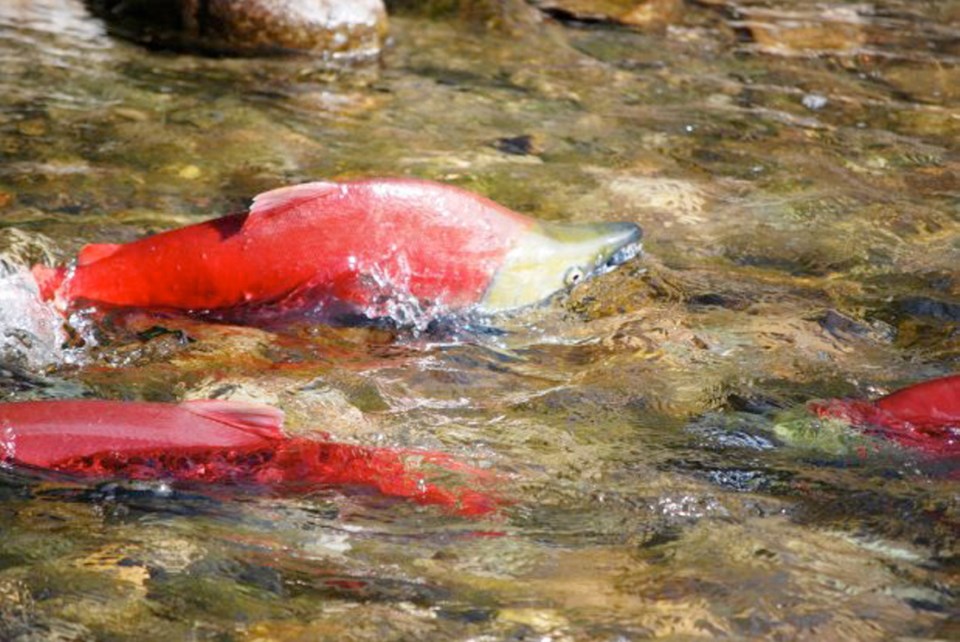This was supposed to be the year of a rebound, a great return for B.C. sockeye salmon. A turnaround. Now, at least for sockeye in the Quesnel waterways, that great return is in doubt.
“The timing of this spill couldn’t be worse in terms of the return of the sockeye,” said Craig Orr, executive director of Watershed Watch Salmon Society.
The peak migration of sockeye in the Quesnel system — which includes the Horsefly River, Quesnel River and Mitchell River, all waterways potentially affected by the Polley Lake tailings pond spill — is expected in about two weeks.
The pre-season forecast for the return of the sockeye salmon in the Quesnel system is 845,000 to 2.95 million, according to Dan Bate, communications officer for Fisheries and Oceans Canada 91ԭ�� Region, a good chunk of the 23 million Fraser sockeye forecast for this year.
Quesnel sockeye have traditionally been a strong sockeye run and a major contributor to the sockeye fisheries, said Pete Nicklin of the Upper Fraser Fisheries Conservation Alliance.
However, for the past two seasons (eight years), returns have dipped dramatically.
“Quesnel sockeye have been a conservation concern according to DFO’s Wild Salmon Policy Status assessment,” said Nicklin.
This year, with a boom season predicted, all the careful management and nurturing of the Quesnel sockeye was supposed to pay off.
“The Quesnel sockeye travel up the Fraser River, turn into the Quesnel River, swim up Quesnel Lake, pass through the exact area of the toxic debris field (left by the tailing pond breach) where Hazeltine Creek meets the lake, turn up into the Horsefly and Mitchell rivers,” said Gord Sterritt, executive director of the Upper Fraser Fisheries Conservation Alliance.
The arrival of a healthy sockeye run, millions-strong in the Horsefly and Mitchell rivers, said Sterritt, would normally be spectacular and noisy. “Fish everywhere, in the water, spawning, digging their nests in the gravel, pairing off, preparing to lay their eggs, you hear them slapping around, protecting their territories.”
Now it’s anyone’s guess as to how this spill will affect the fish. “The fish could be poisoned and it could impact their spawning success rate, or they could make it back to spawn but we wouldn’t know what the cumulative impacts will be,” said Sterritt.
“Because they are filtering the water to breathe, the contaminants could be lethal, that could be the end of them. If they are carrying a load of these heavy metals further upstream they are acting as a vector for a contaminate,” said Ellen Petticrew, an environmental scientist at the University of Northern British Columbia, who was en route to the area Tuesday.
“They are going to have to come through a cloud of this stuff. We don’t really know how they are going to respond to it, if it will stress them or change their signal.”
Salmon can become stressed, disoriented and fail to spawn if they encounter pollutants, debris, changes in water temperature and environment.
As reports of dead fish in the contaminated Hazeltine Creek emerged early Tuesday, John Werring, senior science and policy adviser for the David Suzuki Foundation, said, “You can pretty well say all the fish in Hazeltine Creek are now gone and not likely to return anytime soon. And if fish do get into that system — I’m sure the water will be contaminated significantly for some time — it would be almost impossible for them to survive.”
Information on how the breach of the Polley Lake Mines tailings pond will affect this year’s Quesnel River salmon run and spawning season is still speculative as experts wait for analysis of water samples and word from Environment Canada and the DFO, which have been silent since the toxic spill Monday morning.
��



